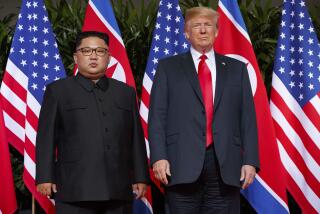LOVE LETTERS An Illustrated Anthology <i> by Antonia Fraser (Contemporary Books: $19.95; 192 pp.)</i>
- Share via
Picking up an anthology of the love letters must surely produce a thrill--followed closely by a hint of suspicion. How interesting could love letters really be? Can they be so different, one from the next? The major appeal of this book is to see how noted historical figures expressed their love. Among the famous loves documented here are those between James Joyce and Nora Barnacle, Voltaire and Olympe Dunoyer, Marcel Proust and various short-lived passions, and Henry VIII and various doomed wives.
Interestingly, Napoleon Bonaparte’s letters to his wife, Josephine, are the most compelling; he seems fully aware of his own excesses. Addressing himself “To Citizen Bonaparte,” he curses “the pride and ambition which force me to remain separated from the moving spirit of my life.” If he seems driven to conquer Europe “with the speed of the Rhone torrent,” he writes, “it is only that I may see you again more quickly.”
A major drawback in “Love Letters” is the deep disappointment that comes from seeing how flatfootedly a literary hero like Chekhov could express himself on this significant topic. In a passage from an ongoing epistolary quarrel, Chekhov instructs his wife: “Don’t forget my fishing rod; wrap it up in paper. Be cheerful and don’t mope, or at least try to look cheerful.”
If some love letters contradict a writer’s popular image, others manage to support every preconceived notion of a writer’s character. Revolutionary Rosa Luxemburg thanks her lover for the gift of an economic tract. Franz Kafka writes in a constant frenzy of uncertainty. Zelda Fitzgerald writes to her husband, F. Scott, in breathless, affectionate phrases strung together with dashes and desperate abandon.
More to Read
Sign up for our Book Club newsletter
Get the latest news, events and more from the Los Angeles Times Book Club, and help us get L.A. reading and talking.
You may occasionally receive promotional content from the Los Angeles Times.










